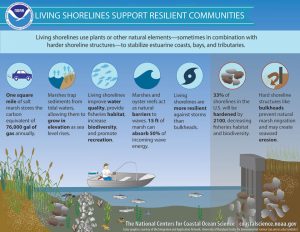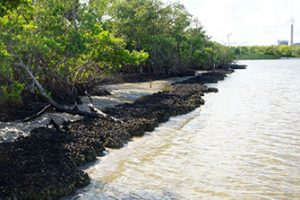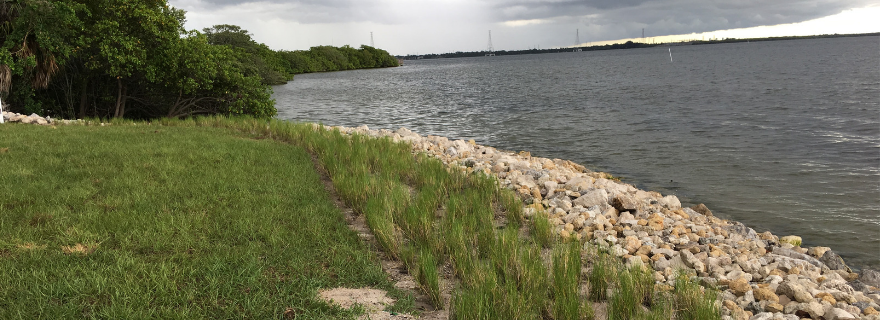Above: The new living shoreline in Safety Harbor replaces an older seawall with areas that already are attracting wildlife.
When we first started writing about living shorelines, the focus was on the pragmatic: a more environmentally friendly way to protect shorelines from erosion.
As people have become accustomed to living shorelines instead of seawalls in some locations, they’re passing the point of practical and become “edutainment.”

The region’s latest public installations – at the Tampa Bay Watch Discovery Center presented by the Milkey Family Foundation at the St. Pete Pier, a replacement for crumbling seawall in Safety Harbor and at St. Pete College’s Bay Pines STEM Center – are all examples of living shorelines that teach and entertain as well as protect.
The living shoreline at the St. Pete Pier – which is expected to host 1.7 million visitors per year – is the highest profile installation. “It’s really the centerpiece of the Discovery Center,” said Peter Clark, president of Tampa Bay Watch. “Living shorelines solve a lot of habitat issues – and you can see the neatest things growing on them.”
Building living shorelines in less accessible locations have been a priority for Tampa Bay Watch, which recruits thousands of volunteers a year to build oyster reefs near eroding shorelines in the bay. “This takes that effort a step further and addresses the need for more habitat in a highly visible location,” Clark said.
It’s being built with a $100,000 grant from Duke Energy, with $25,000 of that set aside to build another coastal habitat that will use Duke volunteers and filmed to be part of “The Tampa Bay Story” highlighting the recovery of the bay.
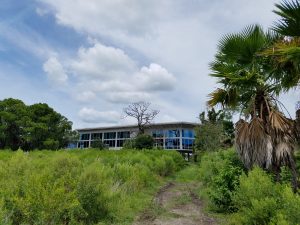
SPC Shoreline Teaches STEM
The St. Pete College Bay Pines project started as a low-cost, long-term alternative to repairing or replacing the dilapidated seawall at the site, said Erica Moulton, director of Bay Pines Center.
“While still relatively a new concept, living shorelines are innovative and cost-effective techniques for coastal management and will provide us with a demonstration site that is welcoming to both the students and faculty here, but also the native flora and fauna,” she said.
Funded with a $10,071 grant from the Tampa Bay Estuary Program, the shoreline will be built and monitored by SPC students in various ecological classes at the waterfront center. “It’s a phenomenal opportunity to showcase a brand-new way of protecting shorelines,” she said. The center also functions as a public learning space where residents can learn how they can help protect Tampa Bay.
From a STEM (Science, Technology, Engineering and Math) perspective, the living shoreline offers multiple opportunities for learning from kindergarten through college, Moulton adds. “We’ll also partner with the Madeira Beach Fundamental School next door where they’re already growing mangrove propagules as part of a science project, as well as having SPC students involved.”
Safety Harbor Shoreline Extends Waterfront Recreation
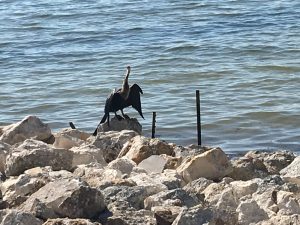
The Safety Harbor shoreline project, just south of the city’s nearly $3 million Waterfront Park restoration, builds upon the popularity of its current boardwalk over Old Tampa Bay which already is attracting people from across the region.
With funding from the Tampa Bay Environmental Restoration Fund (TBERF), an older seawall was removed, the shoreline resloped, and oyster domes placed offshore. Along the shoreline, residents and city staff planted native plants to attract more wildlife. A new spring feature captures the water not used by the Safety Harbor Spa to create freshwater habitat on the bay.
The old seawall was ready to fall, and a living shoreline provides erosion control and plants that attract wildlife and filter stormwater before it gets in the bay,” said Michelle Guillani, project coordinator for the city. “We’re already seeing more birds and folks are out there watching them.”
Living Shorelines Changing Look of Hillsborough River

Few shorelines in the region have been as changed by living shorelines as those along the Hillsborough River. One of the region’s first living shorelines — installed nine years ago at Stewart Middle School — is holding up beautifully, said Tom Ries, president of the not-for-profit Ecosphere Restoration Institute who served as project manager.
And the mangroves planted on a shoreline just off the seawall at Ulele Springs are now approaching seven feet tall, attracting small fish and crabs that bring birds and dolphin up the river.
The newest shoreline on the Hillsborough is pending final approval of permits. Ignacio Haya, a 1,200-foot linear park on the east side just south of the bridge, is eroding away on its northern boundary because of heavier-than-expected boat wakes.
Originally designed in 1999 with small rocks to stabilize the shoreline, Ecosphere applied for a grant from the Environmental Protection Commission of Hillsborough County to design a new shoreline with funding through TBERF. Along with designing a shoreline that handles boat wakes formed as they plow back onto a plane after going under the bridge, the renovation will transform a ditch into a meandering creek that re-creates wetlands along with shore and cleans stormwater before it enters the bay.
And on the drawing board is a revamp of the 800-foot seawall that borders the Straz Center for the Performing Arts with a focus on enhancing visitor’s experience of the waterfront. “It’s part of a master plan that’s now being developed, but they’re committed to a living shoreline,” Ries said.
The Straz has also “thrown down the gauntlet” to other major landowners along the river, including the University of Tampa and the H.W. Blake School of the Arts, to reconsider their seawalls, he said. “Piece by piece, the river is slowing changing.”
Living Shorelines Coming to Pinellas County Parks
Both Pinellas County and the city of St. Petersburg are planning living shorelines to replace seawalls or protect shorelines in key areas including Philippe Park in Safety Harbor, a pocket park in Ozona, Northshore Park and Maximo Park where archeological resources are in danger of being lost. TBERF has funded living shorelines for both Phillippe and Maximo parks.
Plans are still being finalized, Ries said, but the high-profile installations will introduce more people to the concept.
Coming Soon!
Multiple agencies and organizations are creating resources that help waterfront homeowners determine if living shorelines are a good choice — and then how to design and build one.
